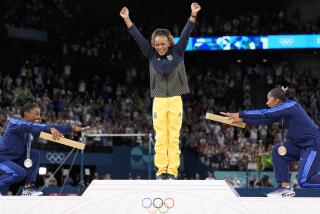In ‘Price of Gold,’ recalling the far-off era of Tonya Harding
- Share via
It can feel like a lifetime ago that the world was transfixed by the Harding-Kerrigan figure-skating scandal -- you know, Tonya, Nancy and, of course, Gillooly, one-word signifiers for the bizarre winter soap opera that preceded the 1994 Lillehammer Olympics.
Memories of that time come rushing back, though, on seeing Nanette Burstein’s new documentary, “The Price of Gold,” a thorough look at the tale of revenge and redemption from the dawn of the modern celebrity age.
Burstein’s film -- produced as part of ESPN’s “30 for 30” series and airing Thursday night on the network -- aims to shed new light on the tabloid-friendly tale, which began 20 years ago this month.
FULL COVERAGE: Winter movie sneaks 2014
Though the film ultimately comes to confirm the popular belief that Harding was aware of, and likely complicit in, the attack on Kerrigan’s knee that nearly derailed the skater’s Olympic hopes, it also draws a subtler picture. “Price” is a film in which Harding’s hardscrabble background and abusive husband -- not to mention the draconian lifetime ban she eventually received from the U.S. skating federation -- create sympathy for the fallen athlete.
“It was easy for a lot of people back then to paint it all as the evil witch versus Snow White, so much so that some even believe it was Tonya who wielded a baton and personally hit Nancy in the knee,” Burstein said in an interview Wednesday. “But the reality was much more complicated.”
Burstein said her own feelings deepened and changed as she made the film, particularly with regard to Harding. “I sort of went up and down with it -- I mean, it’s clear she’s not being forthright when she said she didn’t know about the attack -- but I definitely think she had a raw deal in life.”
That life, as well as a colorful personality, are evident in long interviews with Harding, who though now in her early 40s, hasn’t exactly softened her edges. She can come off as defiant, not only in maintaining her before-the-fact innocence (she pleaded guilty only to hindering prosecution for not coming forth with post-attack knowledge) but also in lashing out at a media and skating establishment she believes favored the camera-ready Kerrigan over her.
At the same time, Harding’s difficult back story (her mother and her ex-husband, that shadowy Jeff Gillooly, appear to have been abusive) offer some mitigating context. And the rush-to-judgment and skating banishment, even in the absence of a conviction, at least bolster some of her railroading claims.
PHOTOS: Behind the scenes of movies and TV
Most ethically complex, several experts note that skating’s popularity skyrocketed in the wake of the scandal and pretty much all the top competitors made millions of dollars as a result -- all except Harding, of course.
Burstein, a veteran documentarian (“The Kid Stays In the Picture,” “American Teen”), takes advantage of the abundant archival footage to reconstruct the story. (And there is plenty of it, most pointedly of a weathered and cash-poor Harding trying to practice at a public rink with hundreds of onlookers and paparazzi bombarding her.)
The director also interviews a wealth of people around Harding and the sport, including many of the reporters who covered the scandal along with skating-world mainstays such as Scott Hamilton and Paul Wylie.
Kerrigan did not participate in the film -- opting, after eight months of back-and-forth with filmmakers, to sign an exclusive contract with NBC for the upcoming Sochi Games, Burstein said. (There are some notable archival shots of the skater, including the famous “why, why” from the locker room of the Michigan skating facility where the attack happened and her equally well-known primetime dig at rival Oksana Baiul when the Russian skater ultimately won the women’s gold and relegated Kerrigan to silver.)
Even with the focus more heavily on Harding, though, Burstein etches a larger portrait of an era.
What’s striking in retrospect is just how innocent in many ways that time was -- Harding fights through it all without so much as a publicist -- as well as the staying power of the story. The nightly news covered the incident obsessively for six weeks running, a streak that in the current short-attention-span media world even Miley Cyrus couldn’t pull off.
BEST MOVIES OF 2013: Turan | Sharkey | Olsen
“This story is compelling because it brings up so many issues, issues of gender in this sport of ice skating, since Tonya was seen as less feminine than Nancy, and issues of class, since Tonya was trailer-park and Nancy was better off, working-class but with a private rink and a sports psychologist,” Burstein said.
But what I found particularly fascinating was that this was a watershed moment for media. It’s when the pendulum first started swinging to tabloid news becoming mainstream news. As Connie Chung points out, you have the New York Times and CBS News alongside the National Enquirer.
With the Olympics and its intense glare again a few weeks away, attention will be trained on a new generation of female figure skaters, particularly young American prospects Ashley Wagner and Gracie Gold. Long out of the limelight in her native Pacific Northwest, Harding appears to have turned her life around, getting married and giving birth to a son several years ago.
There’s no skating, but there are memories and victories and, yes, some resentments, all of a time that somehow seems both vivid and distant.
ALSO:
At ground zero for U.S. film, a Persian wave
Shelton, Corbijn, Gibney lead Sundance premieres
Doing whatever it takes for a spot at the Sundance Film Festival
More to Read
Only good movies
Get the Indie Focus newsletter, Mark Olsen's weekly guide to the world of cinema.
You may occasionally receive promotional content from the Los Angeles Times.











